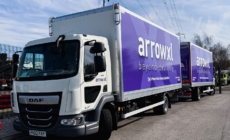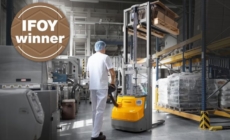-
ROSSLARE EUROPORT TARGETS HEALTH & SAFETY WITH CAMERA TELEMATICS PARTNERSHIP - 2 days ago
-
Landmark Study Reveals Wearable Robotics Significantly Boost Safety and Efficiency in Industrial Environments - July 24, 2024
-
Visku Tackle The Retail Seasonality Challenge One Pallet At A Time - July 22, 2024
-
KAMMAC AND BERGEN LOGISTICS STRENGTHEN FASHION & LIFESTYLE SERVICES IN THE UK - July 19, 2024
-
TENTBOX EXTENDS PARTNERSHIP WITH ARROWXL TO SUPPORT INCREASING DEMAND - July 17, 2024
-
The Perfume Shop improves customer journeys while driving profitability in partnership with Scurri - July 17, 2024
-
ZEROMISSION SECURES £2.3M ($3M) INVESTMENT TO ACCELERATE ELECTRIC FLEETS - July 16, 2024
-
BCMPA CELEBRATES SUCCESS OF 2024 CONFERENCE - July 15, 2024
-
Best of the Best: Jungheinrich Celebrates Triple International Award Win - July 12, 2024
-
GOPLASTICPALLETS.COM CALLS ON NEW CHANCELLOR RACHEL REEVES TO CONSIDER PLASTIC PACKAGING TAX REFORM - July 10, 2024
With the labour pool for UK warehousing running dry, it is time growing warehouse operations look to mobile robots to share the work, explains Frazer Watson, VP-Sales UK/Ireland at iFollow.
Autonomous Mobile Robots (AMRs) offer one of the more cost effective and flexible automation solutions to enable logistics operations to optimise their labour force. This is particularly the case when it comes to the intensive process of accurate order picking and the energy sapping and time consuming necessity of moving goods around a warehouse.
Finding ways to optimise labour has never been more relevant as a list of ingredients is being stirred into a skills shortage stew, which is threatening to take a considerable toll on UK organisations. In addition to sustained low levels of unemployment, the UK labour force remains smaller than it was prior to the Covid pandemic, according to research company Fitch Ratings. In its special report called: ‘Shortfall in UK Labour Supply to Persist’ it detects a ‘curious movement in the UK work demographic’, with a significant proportion of over 50s having left the workforce, and estimates that had the UK’s labour force continued to grow at its 2015-2019 trend rate, it would be around 2.5% bigger than it is today. The Recruitment & Employment Confederation estimates that if labour shortages are not addressed, the UK economy will be £39 billion worse off each year from 2024.
While the UK is not unique in experiencing shortages of workers, numerous commentators in the logistics sector point to changes following Brexit that have reduced the available pool of EU-based workers. This is perhaps a more salient issue for UK warehousing, which is among the sectors hardest hit by the labour shortage as it continues to expand on the back of developments such as supporting continued growth of ecommerce operations. Adding weight to this claim is a survey published last summer by the Chartered Institute of Logistics and Transport (CILT). It revealed that 86% of companies across its membership had experienced warehouse operative staff shortages in the prior two years.
Furthermore, the shortage is combining with persistent inflation to drive upward wage growth. Such a situation can potentially influence broader logistics decisions, such as prioritising labour availability over other strategic business decisions when it comes to locating warehouse operations. Locations that have traditionally attracted distribution sheds have created strong competition among employers for a dwindling pool of labour.
Improving productivity in warehousing through the route of increasing wages is unlikely to be sustainable for many, while investing in training has always been a less than a popular notion in UK business. Faced with the likelihood of long-term staff shortages, many UK warehouse and distribution centre operations are already turning to technology as an aid.
Technology is transforming warehouse work
As entire supply chains become ever more connected, technology enables retailers and their logistics providers to deliver improved service to consumers. Established technologies already include Warehouse Management Systems (WMS), data capture, voice recognition, RFID, pick by light, and all kinds of automated solutions for storage, retrieval, transport and packaging. The advent of mobile robots has moved this on a further step.
Rarely does technology replace people completely, in most instances it complements existing staff, creating collaborative working. This is certainly true of mobile robots, which can take on the more onerous, laborious and time consuming, yet simple tasks such as transporting goods around a warehouse. This leaves their human colleagues to be deployed where they are more productive, such as at the pick face, and creates a vastly more efficient way of working where more can be done with fewer people. Consequently this reduces the pressure on finding staff.
This pressure is particularly heated during peaks, when it’s not just a question a finding people in numbers sufficient to cope with increased orders, but staff that can hit the ground running to maintain service levels. Mobile robots carry on their tasks irrespective of conditions and hours. When businesses scale up or hit peak trading, extra robots can be easily added. This also allows a stepped approach to automated warehouse functions, beginning with one unit and building up a fleet as required, or units can be switched with different capacity models. And because AMRs do not require fixed infrastructure, their routes and duties are extremely flexible, with the programming of tasks via an intuitive fleet management interface.
Optimising labour with mobile robots
Premium mobile robots will have virtues that will allow labour to be optimised even further. An iFollow AMR, for example, can transport two roll cages at once, to a total load of 1,500 kg. This means a picker can work with multiple AMRs simultaneously, so potentially, on a single pick walk an operator supported by two AMRs could be assembling the orders for four different stores or customers. Through this kind of collaboration with the worker, which iFollow calls ‘Duo Picking’, the robot not only frees up a role but it will also reduce time required to carry out a pick. This can bring up to 50% improvement in pick rates by comparison with purely manual methods.
Far from replacing people completely, actively working with technology in ways like this will also increase the appeal of warehouse jobs to tech-savvy young people – a demographic that has the sector has found hard to attract and retain. Unfortunately, warehouse work has acquired a reputation for being hard on employees, low paid and has never ranked among the most desired of occupations. However, unlike many other sectors competing for the same limited labour resource, the work is full time and offers great career path opportunities. Indeed, many of today’s Logistics Managers started out on the warehouse floor. Working with mobile robots adds an attractive and interesting element into the job.
So mobile robots not only offer a collaborative solution that means fewer staff are required, particularly during peaks, but they also add a high tech element to warehouse work that makes the sector more attractive to the kind of recruits an increasingly technology-driven industry desperately needs. Becoming less reliant on labour certainly offers a practical proposition and joins other long-term gains from investing in reliable mobile robots. Their predictable costs, productivity boosting capabilities and flexibility in deployment to handle changes in business are a great way for warehouse operations to reduce their reliance on the availability of people.

































